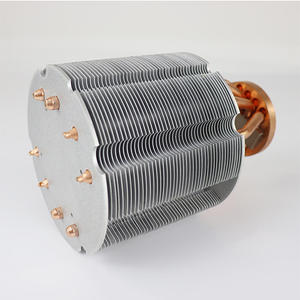
What is a heat pipe radiator? A heat pipe radiator is a new product that uses heat pipe technology to make significant improvements to many old radiators or heat exchange products and systems. There are two types of heat pipe radiators: natural cooling and forced air cooling. The thermal resistance value of the air-cooled heat pipe radiator can be made smaller, and it is often used in high-power power supplies.

Principle of heat dissipation
The heat pipe radiator consists of a sealed tube, a wick and a vapor passage. The wick surrounds the tube wall of the sealed tube and is immersed in a volatile saturated liquid. This liquid can be distilled water, ammonia, methanol or acetone, etc. Heat pipe radiators filled with ammonia, methanol, acetone and other liquids still have good heat dissipation capacity at low temperatures.
When the heat pipe radiator is running, its evaporation section absorbs the heat generated by the heat source (power semiconductor devices, etc.), so that the liquid in the wick tube boils and turns into steam. The steam with heat moves from the evaporation section of the heat pipe radiator to its cooling section. When the steam transfers heat to the cooling section, the steam condenses into liquid. The condensed liquid is returned to the evaporation section through the capillary action of the liquid wick on the tube wall, and the above cycle process is repeated to continuously dissipate heat.
A heat pipe radiator is a high-efficiency heat-dissipating device with unique heat-dissipating characteristics. That is, it has high thermal conductivity, and the temperature distribution between its evaporation section and cooling section along the axial direction is uniform and substantially equal.
The thermal resistance of a heat sink is determined by the thermal conductivity of the material and the effective area within the volume. When the volume of the solid aluminum or copper radiator reaches 0.006m?, the thermal resistance cannot be significantly reduced by increasing its volume and area. For discrete semiconductor devices with double-sided heat dissipation, the thermal resistance of an air-cooled all-copper or all-aluminum heat sink can only reach 0.04°C/W. The heat pipe radiator can reach 0.01℃/W. Under natural convection cooling conditions, heat pipe radiators can perform more than ten times better than solid radiators.
Heat pipe radiators have the following advantages:
1. The thermal response is fast, and its ability to transfer heat is more than 1,000 times greater than that of copper tubes of the same size and weight;
2. Small size and light weight;
3. High heat dissipation efficiency, which can simplify the heat dissipation design of electronic equipment, such as changing from air cooling to self-cooling;
4. No external power supply is required, and no special maintenance is required during work;
5. It has good isothermal property. After thermal equilibrium, the temperature gradient between the evaporation section and the cooling section is quite small, which can be approximately considered to be 0;
6. The operation is safe and reliable, and does not pollute the environment.

The above is to introduce to you "what is a heat pipe radiator", Yuanyang is a professional manufacturer of Heat Sink Heat Pipe suppliers, we support wholesale customization, welcome to contact us.